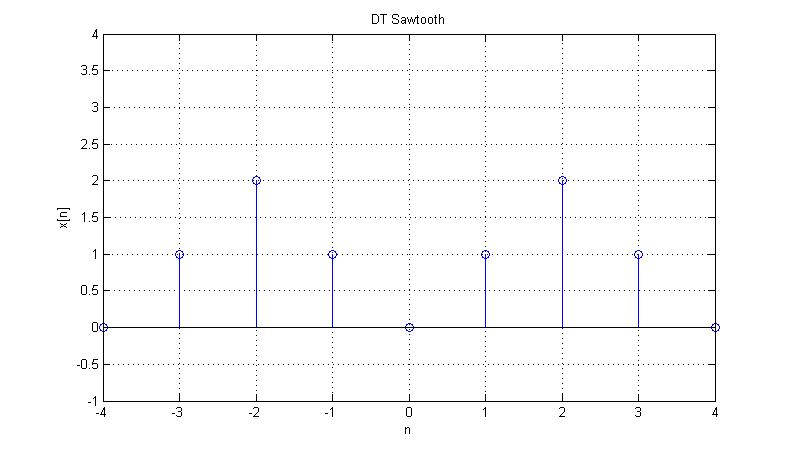| (26 intermediate revisions by the same user not shown) | |||
| Line 6: | Line 6: | ||
==Fourier Series Coefficients== | ==Fourier Series Coefficients== | ||
<math>a_{k} = \frac{1}{N} \sum_{n=0}^{N-1} x[n] e^{-jk \frac{2 \pi}{N} n}</math> | <math>a_{k} = \frac{1}{N} \sum_{n=0}^{N-1} x[n] e^{-jk \frac{2 \pi}{N} n}</math> | ||
| + | |||
| + | From the plot above, N = 4: | ||
| + | |||
| + | <math>a_{k} = \frac{1}{4} \sum_{n=0}^{3} x[n] e^{-jk \frac{\pi}{2} n}</math> | ||
| + | |||
| + | and: | ||
| + | |||
| + | <math>x[0] = 0</math> | ||
| + | |||
| + | <math>x[1] = 1</math> | ||
| + | |||
| + | <math>x[2] = 2</math> | ||
| + | |||
| + | <math>x[3] = 1</math> | ||
| + | |||
| + | <math>x[4] = 0</math> | ||
| + | |||
| + | Therefore: | ||
| + | |||
| + | <math>a_{0} = \frac{1}{4} \sum_{n=0}^{3} x[n] = \frac{1}{4}(0+1+2+1)</math> | ||
| + | |||
| + | <font size="4.5"> | ||
| + | <math>a_{0} = 1</math> | ||
| + | </font> | ||
| + | |||
| + | |||
| + | <math>a_{1} = \frac{1}{4} \sum_{n=0}^{3} x[n] e^{-j \frac{\pi}{2} n} = \frac{1}{4}[(0)(1)+(1)(-j)+(2)(-1)+(1)(j)]</math> | ||
| + | |||
| + | <math>a_{1} = -\frac{1}{2}</math> | ||
| + | |||
| + | |||
| + | <math>a_{2} = \frac{1}{4} \sum_{n=0}^{3} x[n] e^{-j \pi n} = \frac{1}{4}[(0)(1)+(1)(-1)+(2)(1)+(1)(-1)]</math> | ||
| + | |||
| + | <font size="4.5"> | ||
| + | <math>a_{2} = 0</math> | ||
| + | </font> | ||
| + | |||
| + | |||
| + | <math>a_{3} = \frac{1}{4} \sum_{n=0}^{3} x[n] e^{-j \frac{3 \pi}{2} n} = \frac{1}{4}[(0)(1)+(1)(j)+(2)(-1)+(1)(-j)]</math> | ||
| + | |||
| + | <math>a_{3} = -\frac{1}{2}</math> | ||
Latest revision as of 12:40, 24 September 2008
Periodic DT Signal
The following plot shows two periods of the periodic DT signal $ x[n] $, a sawtooth:
Fourier Series Coefficients
$ a_{k} = \frac{1}{N} \sum_{n=0}^{N-1} x[n] e^{-jk \frac{2 \pi}{N} n} $
From the plot above, N = 4:
$ a_{k} = \frac{1}{4} \sum_{n=0}^{3} x[n] e^{-jk \frac{\pi}{2} n} $
and:
$ x[0] = 0 $
$ x[1] = 1 $
$ x[2] = 2 $
$ x[3] = 1 $
$ x[4] = 0 $
Therefore:
$ a_{0} = \frac{1}{4} \sum_{n=0}^{3} x[n] = \frac{1}{4}(0+1+2+1) $
$ a_{0} = 1 $
$ a_{1} = \frac{1}{4} \sum_{n=0}^{3} x[n] e^{-j \frac{\pi}{2} n} = \frac{1}{4}[(0)(1)+(1)(-j)+(2)(-1)+(1)(j)] $
$ a_{1} = -\frac{1}{2} $
$ a_{2} = \frac{1}{4} \sum_{n=0}^{3} x[n] e^{-j \pi n} = \frac{1}{4}[(0)(1)+(1)(-1)+(2)(1)+(1)(-1)] $
$ a_{2} = 0 $
$ a_{3} = \frac{1}{4} \sum_{n=0}^{3} x[n] e^{-j \frac{3 \pi}{2} n} = \frac{1}{4}[(0)(1)+(1)(j)+(2)(-1)+(1)(-j)] $
$ a_{3} = -\frac{1}{2} $


